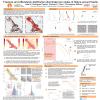Poster #136, Fault and Rupture Mechanics (FARM)
Regional earthquakes that trigger creep on the northern central San Andreas fault
Poster Image:

Poster Presentation
2020 SCEC Annual Meeting, Poster #136, SCEC Contribution #10592 VIEW PDF
eep events (within the 10-minute sampling window) on most of the northern creepmeters, in addition to the previously documented instantaneous triggered creep near Parkfield. After San Simeon, we see a larger ~30 minute delayed creep event on the Harris Ranch and Melendy Ranch creepmeters, and an even larger one day delayed event on the San Juan Bautista creepmeter (XSJ). Notably, the SJT strainmeter (~1km west of the XSJ creepmeter) detected a strain precursor preceding the delayed creep event by less than 1 hour. The timing between the strain transient and the onset of the shallow slip is similar to non-triggered creep events at SJT (Gladwin et al. 1994). We concur that the precursor on SJT indicates that the surficial creep events follow a deeper transient that may be indicative of deep aseismic slip on the fault. During the Parkfield earthquake, all northern creepmeters show some coseismic slip. In addition, the XSJ creepmeter records a two day delayed, larger creep event which also has an accompanying strainmeter precursor indicating sub-soil fault activity. Finally, there are longer-term rate changes associated with these earthquakes. After San Simeon, the XSJ creepmeter average slip rate speeds up from 10 mm/yr to 30 mm/yr, and returns to 10 mm/yr after Parkfield.
Delayed creep events on the northern creeping section following the Parkfield and San Simeon earthquakes may suggest a slow rupture process beneath the San Juan Bautista area that can be triggered by perturbations from a remote source. The data show interactions that couple the northern San Andreas Fault to both the southern locked section and other regional faults.
SHOW MORE
Delayed creep events on the northern creeping section following the Parkfield and San Simeon earthquakes may suggest a slow rupture process beneath the San Juan Bautista area that can be triggered by perturbations from a remote source. The data show interactions that couple the northern San Andreas Fault to both the southern locked section and other regional faults.
SHOW MORE




























































